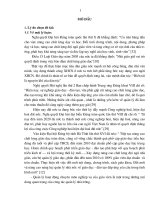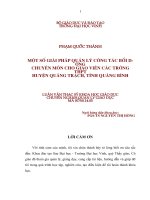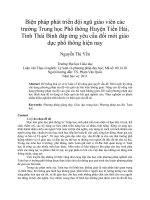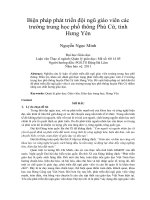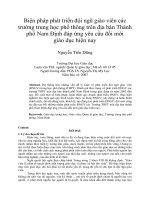Hoạt động chuyển mã ngôn ngữ của giáo viên tiếng anh trung học phổ thông từ quan điểm đến thực tiễn
Bạn đang xem bản rút gọn của tài liệu. Xem và tải ngay bản đầy đủ của tài liệu tại đây (222.64 KB, 34 trang )
THAI NGUYEN UNIVERSITY
SCHOOL OF FOREIGN LANGUAGES
DAO THI NGOC
HIGH SCHOOL ENGLISH TEACHERS’ CODE-SWITCHING:
BELIEF AND PRACTICE
(Hoạt động chuyển mã ngôn ngữ của giáo viên tiếng Anh Trung học
Phổ thông: Từ quan điểm đến thực tiễn)
M.A. THESIS
Field: English Linguistics
Code: 8220201
THAI NGUYEN – 2019
THAI NGUYEN UNIVERSITY
SCHOOL OF FOREIGN LANGUAGES
DAO THI NGOC
HIGH SCHOOL ENGLISH TEACHERS’ CODE-SWITCHING:
BELIEF AND PRACTICE
(Hoạt động chuyển mã ngôn ngữ của giáo viên tiếng Anh Trung học
Phổ thông: Từ quan điểm đến thực tiễn)
M.A. THESIS
(APPLICATION ORIENTATION)
Field: English Linguistics
Code: 8220201
Supervisor: Dr. Nguyen Trong Du
THAI NGUYEN – 2019
CERTIFICATE OF ORIGINALITY
I hereby declare that this submission of the minor thesis entitled “high school
English teachers’ code switching: Belief and practice” is my own work. To the best
of my knowledge, it contains no materials previously published or written by another
person, or substantial proportions of material which have been accepted for the award
of any other degree or diploma at SFL or any other educational institutions. The thesis
has not been submitted to any other examining body and has not been published. Any
contribution made to the research by others is explicitly acknowledged in the thesis.
Thai Nguyen, July 2019
Dao Thi Ngoc
Approved by
SUPERVISOR
Dr. Nguyen Trong Du
Date: July, 2019
ABSTRACT
This thesis presents the findings of a study which aims to investigate how
teachers of English at Vu Van Hieu high school switch between English and
Vietnamese in their classrooms and how this practice match with their beliefs on the
use of both languages in EFL teaching. In order to achieve those objectives, the study
relies on two methods of data collection namely classroom observation and interviews.
During classroom observation, observation sheets were used in combination with
audio
– recordings. Interviews were conducted with the participation of both teachers and
students. Data collected were transcribed, grouped into themes, and explain in details.
Results show that the teachers switched between English and Vietnamese with
different levels of frequency and in different types. The teachers’ code-switching has
some functions such as: to draw attention of students to the lesson, to check whether
students get clear about what they are supposed to do next, to explain the meaning of
vocabulary and the usage of grammatical phenomenon, and to deliver instructions and
tighten the mutual relationship between teachers and students. These findings go quite
well with what the teachers and students say about code – switching. On the other
hand, both teachers and students believe that using Vietnamese is necessary for the
effectiveness of the teachers’ instructions. Moreover, they both agreed that the amount
of Vietnamese used in EFL classrooms should be reduced to minimum and should be
based on students’ competence.
Chapter 1: INTRODUCTION
1.1. Introduction
1
Nowadays English is considered as a global language, and the majority of
people who use it as a tool of communications are non-native, i.e. most of the users are
bilingual or multilingual. It is commonplace to see English being used and studied
without a linguistic environment beside classroom hours; English is rarely used in
their real life. Therefore, in English teaching and learning context, code-switching is
also seen as inevitable either on purpose or by chance.
Code-switching in classrooms has been discussed for several decades
worldwide, and research on this case is often conducted to find out how codeswitching takes place between English and another language such as: Chinese,
Spanish, Vietnamese, Turkish and German and so forth (for instance, Auer, 1998,
Ferguson,
2003; Flyman, 1991; Marcaro, 2009; Sert, 2005; a well-known Vietnamese Nguyen T.
N, 2016; and other teachers of English. It can be said that nowadays, code-switching is
one of the most emerging trends in linguistic field, particularlyin bilingual or
multilingual environments.
During the history of the matter as Macaro (2013) proclaimed, the major issues
in code-switching debated include causes, types and its roles in teaching and learning
English. Additionally, researchers keep a close eye on how teachers’ perceive and
practice their code-switching in the reality or whether code-switching serves as a
functioning tool in assisting learners or appear to be stumbling blocks for them in
acquiring language skills. Consequently, publicized reports often mention the
weaknesses as well as the strengths of code-switching.
In line with the academic study trend of code-switching worldwide, there have
been voices from Vietnam in the form of conference reports, articles, master and
doctorate thesis, which are popular with research conducted by teaching staff from
universities throughout Vietnam as well as oversea Vietnamese linguists. Many of the
researchers specialized in this field have focused on analyzing theoretical matters as
well as exploring the ongoing facts.
1.2. Rationale
English is widely regarded as one of the key languages that help Vietnam
integrate into the world; therefore, studying English plays an important role in almost
1
all Vietnamese school curricula. However, in the classroom where English is treated as
a foreign language (EFL), as a teacher of English and after years of teaching, I have
realized that many Vietnamese teachers face several challenges in their attempt to
make their students comprehend. This issue has raised heated discussions among
teachers over the problem of how and how much Vietnamese should be exploited in
order to assure students’ understanding as well as to achieve the goals set in teaching
procedures. Therefore, the aim of this study mainly focuses on figuring out how
teachers’ belief matches with what they do within their teaching practice at Vu Van
Hieu high school.
This is the reason that leads to the study proposal entitled “High school
English teachers’ code switching: belief and practice.” The study is expected to help
high school teachers investigate the code-switching in depth as it can shed light on the
beliefs and practices of code switching in the teaching of English as a second
language in bilingual classrooms.
1.3. Aims of the study
This study deals with high school English teachers’perception and their codeswitching between English and Vietnamese in the classoom and aslo uncovers how
much their realities match their perception, i.e, between their belief and their practice.
1.4. Research questions
Based on the aims set up above, the study tries to answer the following two
questions:
1. How do teachers of English practice code-switching in their English classes?
2. How do their practices of code-switching match with their perception and
students’ opinions about the use of English and Vietnamese in their English classes?
1.5. Significance of the study
This study asserts the key factors including the culprits, the effects and the aims
of code-switching of the teaching process, and the relationship between beliefs and
practice of teachers in the classroom.
Furthermore, in this study, it is hoped that the findings will give me some
experience of teaching English as well as equip myself with up-to-date knowledge in
code-switching with my colleagues.
1.6. Scope of the study
2
The study focuses on the teachers’ opinions about using both languages
(English
2
and Vietnamese) and their common practice of using them. In other words, it places
focus on what they say and what they do with regard to their use of languages in their
instructions of English.
1.7. Design of the study
The thesis consists of five chapters as follows:
Chapter I: Introduction. This chapter includes the rationales of the study, the aims and
scope of the study as well as the research questions.
Chapter II discusses the previously conducted research by both foreign and domestic
authors to give the whole picture of the matter. This this chapter, key definitions are
brought forward including bilingualism, code-switching as well as their types and
categories and so on.
Chapter III is composed of methodology which consists of the key methods of
collecting and analyzing data. Also, in this chapter participants and procedure of the
thesis are mentioned and analyzed in depth.
Chapter IV analyses the data obtained from interviews as well as classroom
observation. Chapter V concludes the findings of the present study as well as the
suggestions for further study and the shortcomings of this thesis.
Chapter 2: LITERATURE REVIEW
2.1. Previous studies
The pioneers in this field in the 1970s can be mentioned such as Fishman,
Platt& Platt with the studies published in 1971 and 1975 respectively. Those
3
described and discussed the situation of individual cases and code-switching
patterns. In the later
3
decade, linguistics including Romains (1989) and Poplack (1980) classified two main
constraints of code-switching: morpheme and equivalence in syntax. In the last decade
of the twentieth century, linguists paid more attention to causes of code-switching and
role of teachers in the classroom where code-switching took place. This movement has
resulted in projects concerning classroom context of bilingualism, such as English and
French by Flyman and NicolasBurenhult (1991) with the study named “Codeswitching in second language teaching of French”. The role of code-switching lied in
the heart of focus. Undoubtedly, in Flyman’s research, switching codes was used a tool
of emotion expression (anger, sympathy), topic change, misunderstanding avoidance.
In the period of that decade, the core of linguists’ attention appeared the frequency
and the area in which teachers’ speech was code-switched, for instance, Martin-Jones,
M. (1995) claimed that code-switching in the classroom context was notably between
English and Spanish. Additionally, it served various functions.
Since the twenty first century has benchmarked a booming era of codeswitching studies in which many other languages are the subjects of examination, for
instance, code-switching between English (the most common language) and Malay,
Chinese, Japanese, African languages and so forth. Discussions among scholars upon
the use of mother tongue, types and functions of code-switching have been raised and
heated. However, the above mentioned study findings just made a list of codeswitching types, reasons or purposes regardless of explaining the advantages or
disadvantages of code- switching in the classroom. On the contrary, others reasoned
that code-switching was beneficial towards students’ learning.
Nowadays, code-switching is widely accepted as a teaching method, thus,
attitudes expressed by students and teachers have been the subjects of focus.
In terms of code-switching history in Vietnam, it surely first officially started
when French settlers opened schools. The majority of studies concentrate on codeswitching behaviours and patterns in the classroom and nearly most of the studies are
of ten years of age; typically, the researchers are both domestic and oversea teachers,
lecturers and linguists, such as Nguyen, T. N (2016), Nguyen, H. Q. (2011) and others.
It is suggested from the above revision that code-switching be an integral part
of teaching process. More or less, it still exists, and as a result, it is even accepted as a
teaching method. Even several linguists have admitted its effectiveness and benefits in
4
teaching and learning although others emphasized its negative effects.
2.2. Bilingualism and code-switching
Grosjean (1982, p.18) pertained bilingualism as “the regular use of two or more
languages” regardless of levels of proficiency. Bilingualism is categorized in three
types by Weinrich (1953) including compound, coordinate and subordinate.
Code-switching is viewed differently by bilingual researchers, whereas it is
generally accepted as switching from a language to another. In the classrooms, codeswitching, the common standpoint amongst researchers often links it with the usage of
mother tongue or source language (L1) and the foreign language, in other words,
target language (L2).
2.3. Code-switching in teaching and learning context
2.3.1. Definition of code-switching in teaching
Teachers’ code-switching has been categorized into two broad groups, namely,
classroom management and content transmission by Canagarajah (1995). Later on,
Ferguson (2003) developed the idea to part of curriculum access, classroom
management and interpersonal relations.
In the classroom context where code-switching is not an exception, it is widely
accepted that using two languages alternatively is code-switching. Teachers of foreign
languages are the ones who use code-switching in classrooms as a teaching aid in their
lessons.
In teaching context, code-switching relates to how often and types of code
switching are employed by teachers and how it affects the learning result of students.
Some other notable definitions of code-switching can be seen as “the mixing of words,
phrases and sentences from two distinct grammatical (sub) systems across sentence
boundaries within a speech event” (Bokamba, 1989, p.279).
In conclusion, code-switching is still a controversial issue among researchers.
However deeply it is studied, there will not be a single definition. It is obvious in
previous studies that code-switching is used intentionally in the classroom. The
reasons are diverse, however, the final purpose is to “help students to learn
English” (Lee,
2010, p.256).
2.3.2. Purposes and types of code-switching
5
Code-switching is a common activity in the English lessons led by teachers in
5
both multilingual and bilingual classes. In fact, this phenomenon is employed to serve
the following purposes:
It is believed that there is plethora of sorts of code-switching including,
according to classification by various researchers and, afterwards, listed by Rebecca
(2010, p.3) in four main types as teaching grammar, checking comprehension, social
reasons and time pressure.
Code-switching, in the contention of Appel and Muysken (1987) is classified
into two types, including intrasentential and intersentential. i.e. intrasentential codeswitching occurs within a sentence; however, intersentential happens among
sentences.Based on the results of studies by Poplack (1980), Nguyen, T.H. (2013)
summarized code-switching into the three following types:
Extra-sentential (equals to intersentential) or tag-switching in which teachers
insert tags including fillers (ah, uh, hm and so forth), besides, the tags can appear at
the end or in the middle of the sentences.
Intrasentential code-switching is composed of supplementing the sentence of
the target language with parts of speech of teachers’ mother tongue whilst not
violating the target language’s grammatical rules or vice versa.
Intersentential code-switching, according to Poplack (1980) (as cited by
Nguyen, T. H.) occurs within a clause or a sentence.
2.3.3. The importance of Code-switching in teaching context
In Norrish’s (1997) opinion, code-switching was employed when the
information in the text book was beyond students’ acquisition ability, in addition,
when teachers could not find any better methods to adapt complicated knowledge to
students’ level.
Cole (1998) emphasized the pivotal part of code-switching as a tool to enhance
students’ awareness and responsibility in learning, as a result, the classroom
atmosphere would be free of anxiety. It surely brought about better results. Therefore,
it is essential to perceive the functions of code-switching as Sert (2005) noted “will
obviously lead to better instruction by either eliminating it or dominating its use
during the foreign language instruction” (Sert 2005, p.56).
In the aspect of the necessity, Cook (2001) highlighted that teachers should use
6
their first language; however, in a relevant amount, to clarify their instructions of
activities that benefit students.
According to Badruh (2009) code-switching is crucial since, psychologically
speaking; it provides a conductive environment in the classroom whistle satisfies
students in their learning process.
The role of code-switching was indicated by many researchers and scholars,
such as: Flyman (1999), Lui (2001), Ahmad (2009), Xu (2010), Lee (2010) and so on.
Ciprinani (2001) claimed code-switching can be used by teachers to repeat .i.e. when
the teacher facilitates a task management, he or she can use L1 (mother tongue) to
emphasis the task. When Zabrodjkaja (2007) observed the teaching and learning at a
university, she drew a conclusion in which teachers switched between two languages
(mother tongue and English) but in case of necessity, to praise students. Gearon (2011,
p.148) pointed out that code-switching was an important strategy to “assist learners in
immersion programs”.
There have been numerous research conducted worldwide that appreciated
code- switching. For instance, a study by Badrud and Kamaruzaman (2009) shows that
nearly
75% of the respondents asserted their teachers’ code-switching was to check
understanding.
A questionnaire on the role of code-switching handed out in a study by
IsratJahanShichi&A.B.M. Shafiqul Islam (2016) has revealed that teachers switch
codes in order to: compare syntax problems in teaching grammar, show relationship or
differences between languages, clarify key words in the lessons, make the class more
interactive, make class discussions lively, make sure students have got the right
meaning of new words, get students penetrate into the lessons.
It is undeniable that code-switching has assisted students interpret classroom
instructions at the beginning, helped them to understand the meaning of words,
especially, abstract connotations or concepts. Above all, code-switching has led to
students’ proficiency improvement.
2.3.4. Teachers’s beliefs and practices
One of the key factors that considerably impact on the effectiveness of students’
7
learning and teachers’ teaching in the classroom context appears to be teachers’ beliefs
8
in their teaching in the classroom.
In terms of foundation, beliefs of teaching are formed on the basis of teachers’
experience as instructors at work and as learners at university previously. In other
words, teachers’ beliefs about teaching and learning are formed during their study at
university and thence, their professional activities after graduation
Teachers’ beliefs about teaching and learning activities play an important role
in their latter practice owing to what they bear in mind, therefore, beliefs are often
episodic and are not generally tested and proved true for all teachers.
Teachers’ beliefs is composed of, according to Kindsvatter and many other
researchers, experience as a learner in their early stage at university, theory gained
from books, practical activities at work as well as their personality.
How do teachers feel about practicing code-switching in their classrooms?
From Richard’s viewpoint (1998, p.94), teachers are “information, attitudes,
values, expectations, theories and assumptions about teaching and learning”. With
regard of belief, Burn (1992) referred that what teachers believed would effect on their
teaching. However, there are teachers who are pessimistic about their code-switching.
In the study conducted by Rebecca (2010), she pointed out the feeling of a teacher
participant when using the mother tongue in English class as “not the right way”.
In the aspect of frequency, the majority of teachers agreed that mother tongue
should be use sometimes in the classroom. In the reasons why mother tongue was used
in the classroom, the researchers summarized five main culprits which were: it
contributed in assisting comprehension, it was time-saving, it made students more
comfortable and confident, managed behaviors of students and established rapport.
To summarize, code-switching is beneficial when relaxing students, giving
feedback, assessment, establishing relationship with the learners, explaining
unequivalent structures, proving cultural knowledge. The code-switching activities
depend very much on how the teachers see their own code-switching in the classroom
context.
2.3.5. Relationship between teachers’ code-switching beliefs and practices
In terms of relationship between practice and beliefs of teachers in their
classrooms, Johnson (1994, p.439) reveals that teaching practice is influenced by
teacher’s belief; therefore, “understanding teachers’ belief is essential to improving
8
teaching practices”.
To be more detailed, types of code-switching, the causes and the time when this
phenomenon happens and the relation between code-switching and bilingualism are
studied in my study.
Researchers, such as Richards and Weber (1985), approved teachers’ codeswitching as a way to facilitate communication, and they argued that teachers switched
codes to improve the learning process. Johnson (1992) found out that teachers’
concept about teaching English via mother tonguecan help student shape their own
learning
style.
Researchers used various forms to identify how beliefs and practice are linked
to each other, such as: class observations, interviews (Jones and Fong, 2007), (Yon,
2012), lesson plan analysis (Johnson, 1992).
However, many reseachers have found the negative relationship between the
two above mentioned aspects. Although the purpose of the lessons were
communicative approach, the practices were rules based on grammatical rules.
2.3.6. Functions of code-switching in the classroom
Although code-switching is still a controversial matter in which several
linguists approve while others discourage, it is a tool of teaching in many cultures or
circles of bilingualism. As mentioned in many studies as targets of researchers, codeswitching serves the following functions:
Flyman (1991) categorized code-switching in five major functions including
linguistic insecurity, topic switch, affective functions (i.e. teachers switch codes to
show their feelings), socializing functions (to maintain relationship, solidarity etc),
repetitive functions (to make sure students understand teachers’ instructions). Gibson
F. (2003, p.38) revised the code-switching functions as a tool to assist students’
comprehension, to manage the classroom activities and to ensure relationship in the
classroom. Nguyen T.N. in his study’s review quoted some researchers’ opinions,
such as Garcia’s, Moodley’s view on the function of code-switching as a tool to
spread teacher’s knowledge, check understanding and feedback; boost relationship
between teachers and students and so forth.
9
In sum, in spite of the difference in the number of kinds in code-switching, the
above mentioned researchers seemed to adopt code-switching as a useful tool in
teaching activities in the classroom.
2.3.7. Definitions of terms
Code Switching: There are numerous of definitions of code-switching,
however, according to Soodeh (2012, p.219) “Code switching is the communicative
exchange between two languages codes among people who contribute to those specific
codes.”
Bilingualism: It is stated in the study published by Verplaetse (2010, p.559) that
“bilingualism is defined as a speaker’s ability to use two languages for
communication”. Students and teachers at Vu Van Hieu high school are
comprehensive bilingual, thus, code-switching is unavoidable.
Chapter 3: RESEARCH METHODOLOGY
3.1. Research Design
The study is qualitative research and narrative analysis. To find out the
teachers’ beliefs and practices of code switching applied in EFL classrooms at Vu Van
Hieu high school, both observations and interviews, namely group-focus interviews,
are chosen as methods for my thesis. Three teachers and three students from my
school at all grades were selected as participants. Data is explained, evaluated to
comprehend the teachers' beliefs and the way they put their opinions into practice.
3.2. Instruments of data collection
There are numerous tools of collecting data for a scientific research, such as,
questionnaires, interviews, surveys and so forth.
In order to gain the most reliable results, I used two instruments to collect data,
including observation and group interviews.
10
3.2.1. Classroom observation
In order to find the answer to the question “How do teachers practice their
code- switching?” Observation was conducted at random throughout the 2018-2019
academic year. Of course, prior to choosing a lesson, the thesis author had been
permitted by teachers who took part in this study. In the observed lessons, an
observation sheet is a must-have for the researcher to write down every detail that
serves the purpose of the observer as Masoumeh stated “an observer should write
down everything he or she sees and hears”. Therefore, a classroom observation sheet
was designed and it was assisted by a recording. Before the observation took place,
teachers and the thesis author had a brief discussion about the lesson, the aims and the
place of the observer.
3.2.1.1. General concepts
As Reed and Bergemann (2001, p.6) reclaimed classroom observation “the
bridge between the worlds of theory and practice”, therefore, theory, in this case
beliefs of qualified teachers, can be examined in certain and specific situations.
Another view about classroom observation proclaimed by Mathew T. Hora
(2013) is that it is a method which helps observe directly and recurs in real time
Peer observations are one of the most popular methods in Vietnam in which
fellow colleagues accumulate information in terms of teaching methods, the accuracy
of the content. For the sake of the thesis’ purpose, the researcher of this thesis mostly
uses peer observations since its participant teachers feel much more confident and
more relaxed when being observed.
Classroom observations provide rich data on which administrators and fellow
teachers rely on their assessments and evaluations. The achieved data can also be used
for research as well as for professional development activities in the successive
teaching practice.
3.2.1.2. Procedure
Pham, V. H. (2004) drew four steps of conducting classroom observation
including collecting material, preparation, observation and feedback. In the third stage,
in the classroom the observer collects data selectively and focuses on choosing
materials and document that are able to answer the preset questions. Feedback is
11
normally understood the final step when observers and teachers sit together and
discuss about the
12
strengths and weaknesses of the teaching method applied in the lesson. Afterwards,
both sides have an opportunity to overtly and frankly speak out their views and
beliefs.
For effective observations, there are a few things to be prepared beforehand,
such as, field notes which mark time and procedure of the lesson; the observer must
think twice about the most suitable seating; checklist which ensures the observers do
not get out of track as well as do not miss anything; a follow-up conversation is a
“must” in order to facilitate both sides to explain and discuss.
3.2.2. Focus group interviews
A focus group interview is one of the effective methods in a qualitative research.
Anderson (1990, p.241) defined it as “a group comprised of individuals with
characteristics who focus discussions on a given issue or topic.”
As a group interview is regarded time-consuming, to arrange a meeting for a
focus group interview I had to ask for permission of every member including teachers
and students.
3.3. Participants
For the purpose of the thesis, the participants are picked up at random
(for students), namely, for each class, a representative is selected in regard of their
study reports, diversity of levels, grades, age groups.
The chosen participants are divided into two groups including teachers group
and students group. In the teachers group, there are three experienced teachers using
the latest teaching materials. In students group, there are three of them coming from
different classes and representing three grades at the school.
3.3.1. Teachers
The central role of this thesis is played by the three teachers at Vu Van Hieu
high school. Due to the small amount of number, all the three my co-workers are
willing to participate in the study. However, all of the teachers-participants urge to be
anonymous in the study, hence, their names are numbers from one (T1) to three (T3).
Moreover, their teaching lessons are not allowed to be published beyond this study.
Several lessons which have been chosen at random to be observed are under their
permission.
3.3.2. Students
13
Students are guaranteed to hide their real names and encouraged to tell the truth
about their feelings towards English lessons as well as their teachers’ code-switching
14
during the lessons in general, not just code-switching in the observed lessons. They
are only informed about the interview shortly after the observation but fully provided
with information of the interview. They are all informed that the content would be
recorded. Some of the selected are under eighteen years of age; hence, the agreement
of the principal appears decisive.
3.3.3. The moderator
I work as the moderator of the interview in order to ensure the interview will
not get out of track. Also, I myself am a fellow teacher of the participants. Hence, the
interview is believed to be a talk among co-workers speaking out the common issues
emerging in teaching.
3.5. Data collecting procedures
+ Preparation for the observations
For classroom observations, observation sheets, field notes, a recorder are
always in a full ready state. In order to confirm the legacy of the observations, all the
documents, such as, confirmation letter, agreement letters have been signed before the
official class hours. Each of the recorded lessons is the final result of the agreement
between observed teachers and the author of this research. In case of not missing any
precious and valuable details of the observed lessons, field notes can be used to
register emotional responses in the classroom.
The content of the lessons is critically transcribed in written form which,
afterwards, becomes a primary source for the upcoming analysis.
+ Preparation for the interviews:
Before and at the beginning of the interview, both all the fellow teachers and
students are informed about the purpose, activities of the talk. Adequate preparation
can guarantee the smoothness of the talk; as a result, the outcome was more reliable.
Place for the meetings are registered and keep secret in order not to disturb
others at the school. Additionally, the place of interviews is in the school’s campus
and it takes place after working hours.
Prior to the interview to take place, a list of most possible questions has been
chosen in advance.
3.5. Data analysis
In the thesis, the deductive thematic method has been used for the following
reasons:
13
